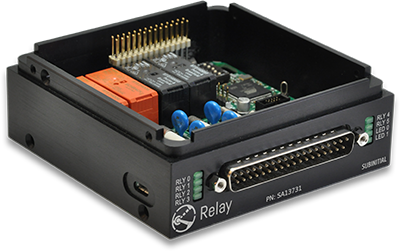

The Relay Deck provides a number of relays for user control. Its mechanical relays allow switching high power loads and its solid-state relays provide an alternative for lower-power loads. When connected to the Core, the Relay Deck is a seamless expansion of the Core’s functionality. Just like the Core, it can be controlled using Python.
The Relay Deck contains four mechanical relays, two solid-state relays, and two opto-isolated inputs. Two of the mechanical relays are SPDT rated at 250VAC with an internal 8A fuse, and the other two are DPDT relays rated at 250VAC with internal 4A fuses on each pole. All relays have the Normally Open (NO), Normally Closed (NC), and Common (COM) terminals accessible. The SPDT relays have transient overvoltage protection across all contacts for extended contact life with inductive loads. Each SPDT relay and DPDT has true RMS current readings through DC and AC current sensing to ±50A.
Two solid-state relays are provided along with two opto-isolated inputs. One solid-state relay is rated at 250VAC with internal 1A fuse. It is for AC only, as it is triac-based. The other solid-state relay is rated at 48VDC with internal 750mA fuse. It can be used for AC or DC, as it is MOSFET-based. Both solid-state relays have overtemperature protection. The opto-isolated inputs act as discrete inputs and can measure ±3VDC up to 250VAC directly. These inputs can easily be programmed to automate triggering, such as turning on relays 1 and 3 when AC power is detected.
A full bodied hard anodized aluminum enclosure provides physical protection for the Relay Deck. Electrically, the Relay Deck I/O are designed with industry-standard protection, and all I/O are galvanically isolated from the Stacks Core and all other Decks.